African Animals
African animals: Nothing compares to the exhilaration of observing wildlife on an African safari. The early morning expectancy as the sun rises above the horizon, the rustling leaves suggesting concealed creatures, and the awe-inspiring sight of a lion surveying its domain — these moments remain etched in memory indefinitely.
After extensive hours spent on safari in some of the world’s premier wildlife reserves, we have carefully compiled a list of the 50 most desirable species you may encounter during your African expedition. This comprehensive guide, informed by substantial research into tourist preferences, online search trends, and expert suggestions, emphasizes the most iconic, elusive, and ecologically significant creatures that characterize the allure of the African bush.
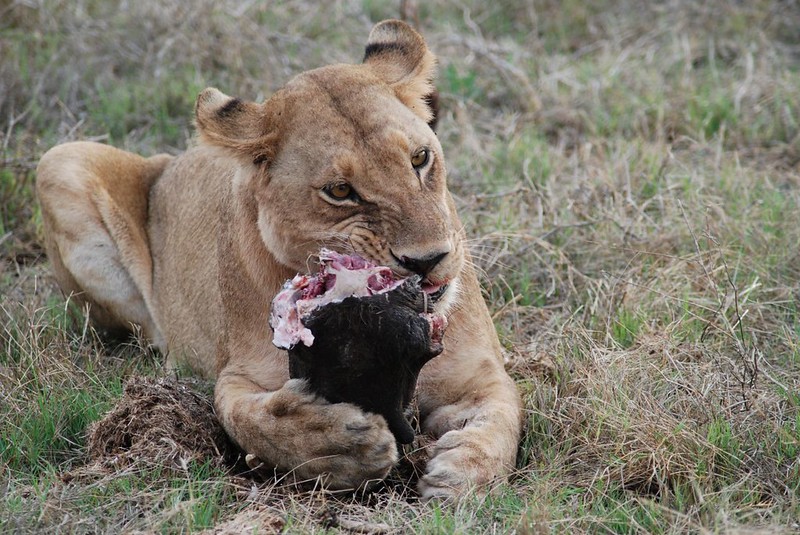
We will provide expert advice on locating them, enhancing your likelihood of sightings, and present captivating photographs to inspire your safari aspirations. From the renowned Big Five to the lesser-known yet equally captivating species, each animal contributes significantly to the complex ecosystem that renders the African wilderness exceptional. Prepare to be enthralled as we navigate the varied and mesmerizing realm of African safari wildlife.
African Lion
The lion occupies a dominant position at the apex of the food chain, devoid of natural predators, and governs the expansive African plains. Lions, the largest and most majestic of all felines, inhabit in prides governed by a solitary male. Their emblematic manes and formidable roars signify their strength and supremacy. Lions, primarily hunters, also engage in scavenging, demonstrating their adaptation to the harsh savanna habitat.
How to spot lions
Unencumbered by the presence of other animals and devoid of the need to conceal themselves, they are the most conspicuous felines during a game drive. Lions engage in nocturnal hunting and repose during daylight, seeking refuge from the sun beneath trees or dense foliage. The optimal opportunity to observe them occurs at morning when they may still be foraging, or at nightfall when they prepare for the night. Pay attention to their characteristic roars, audible from several kilometers off.
Locations to Observe Lions
African lions are found across Africa, with optimal locations in eastern and southern regions.
Serengeti National Park and Ngorongoro Crater, Tanzania: The Serengeti is home to a substantial lion population, providing optimal opportunities for sightings on game drives, particularly around the Grumeti River. The Ngorongoro Crater possesses one of the largest lion concentrations globally, rendering it an optimal site for studying their social dynamics.
The Masai Mara National Reserve in Kenya borders the Serengeti and is an exceptional site for observing lions, especially during the Great Migration when prey is plentiful.
Kruger National Park, South Africa: The park, which hosts a substantial lion population, provides varied habitats for these predators, ranging from wide savannas to riverine zones.
The Okavango Delta in Botswana is renowned for its substantial lion prides and distinctive opportunities to observe their hunting behavior in and near water.
Queen Elizabeth National Park, Uganda: This park is distinguished for its tree-climbing lions, a rare activity noted in the Ishasha area.
African Elephant
The African elephant is the largest terrestrial creature on the planet, emblematic of knowledge, strength, and social connections. These large mammals traverse the savannas and forests of Africa in matriarchal groups, exhibiting intricate emotions and exceptional intelligence. Their substantial tusks, utilized for excavation, elevation, and protection, are regrettably a target for poachers, rendering their conservation a pressing concern.
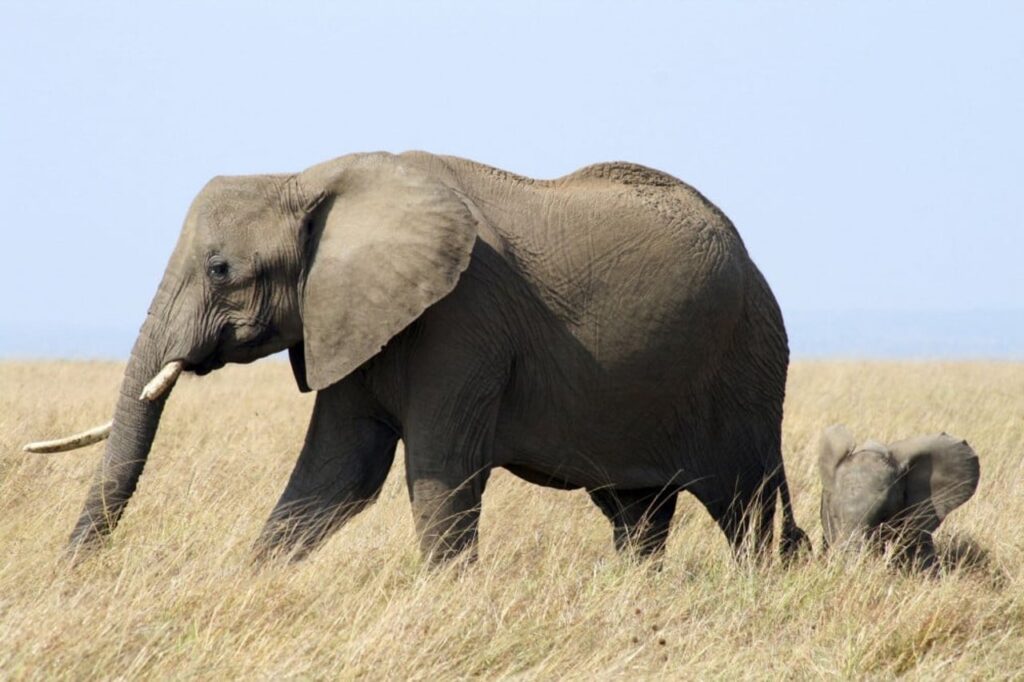
Identifying Elephants
Elephants are easily identifiable because of their size and unique characteristics. Observe their substantial, flapping ears and elongated trunks, which they utilize for diverse functions, including foraging, hydration, and communication. Pay attention to the rumbling noises they produce, along with the snapping of branches as they traverse the underbrush. Elephant feces serve as a reliable indicator of their existence.
Locations to Observe African Elephants
Elephants inhabit many ecosystems throughout Africa; nonetheless, the following locations are optimal for observation:
Chobe National Park, Botswana: Chobe is home to one of the greatest elephant populations in Africa, providing exceptional opportunities for sightings along the Chobe River and in the adjacent woodlands.
Hwange National Park, Zimbabwe: This expansive park hosts substantial populations of elephants, frequently observed gathering near waterholes, especially during the arid season.
Amboseli National Park, Kenya: Amboseli provides breathtaking vistas of elephants set against the backdrop of Mount Kilimanjaro, an emblematic African landscape.
Addo Elephant National Park, South Africa: This park was created explicitly to safeguard elephants and provides outstanding opportunities for close encounters with them.
Murchison Falls National Park, Uganda, hosts both savanna and woodland elephants, providing varied viewing opportunities. The park’s boat excursions on the Nile River offer distinctive opportunities to observe elephants from the water.
Mountain Gorillas
Mountain gorillas are formidable yet compassionate creatures, recognized for their strong familial bonds and unexpectedly human-like expressions. These severely endangered primates reside in the verdant, mountainous highlands of central Africa. Witnessing their social dynamics, from spirited juveniles to the authoritative silverback, is a profound and indelible experience.
Identifying Mountain Gorillas
Mountain gorillas are among the most notoriously challenging African safari animals to track down due to their secluded habitat and elusive disposition. To observe them, one must undertake a gorilla trekking expedition, accompanied by knowledgeable guides familiar with the gorillas’ habitat. Prepare for a physically challenging journey through dense foliage, as the pleasure of encountering these amazing creatures justifies the exertion.
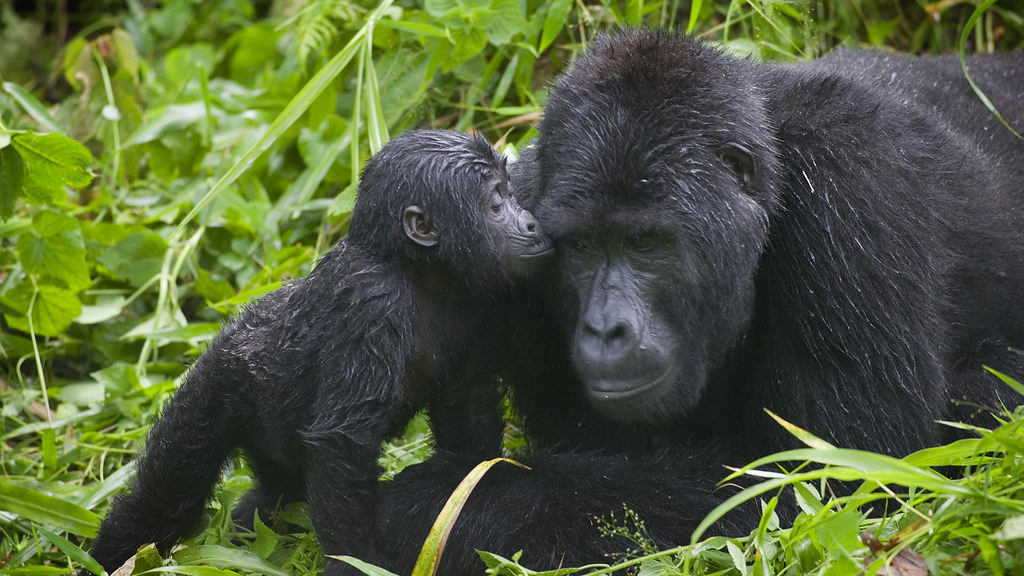
Locations for Observing Mountain Gorillas
Mountain gorillas are exclusively found in three African countries.
Uganda: Bwindi Impenetrable National Park and Mgahinga Gorilla National Park harbor approximately fifty percent of the global population of mountain gorillas.
Rwanda: Volcanoes National Park is an exceptional site for gorilla trekking, with breathtaking vistas of the Virunga Mountains.
The Democratic Republic of Congo (DRC) is home to Virunga National Park, the oldest national park in Africa, which provides opportunities for gorilla trekking; however, the security conditions in the area may be volatile.
Gorilla trekking permits are essential and should be reserved in advance due to restricted availability. These licenses facilitate conservation initiatives and provide financial support for the safeguarding of these endangered primates.
African Leopard
The African leopard excels in camouflage and stealth, rendering it one of the most elusive and coveted creatures on safari. Their striking rosette-patterned coat facilitates perfect camouflage in the dappled light of the jungle, while their remarkable climbing abilities permit them to conceal their prey high in trees, away from scavengers. Leopards are solitary animals, frequently observed at night, enhancing their enigmatic appeal.
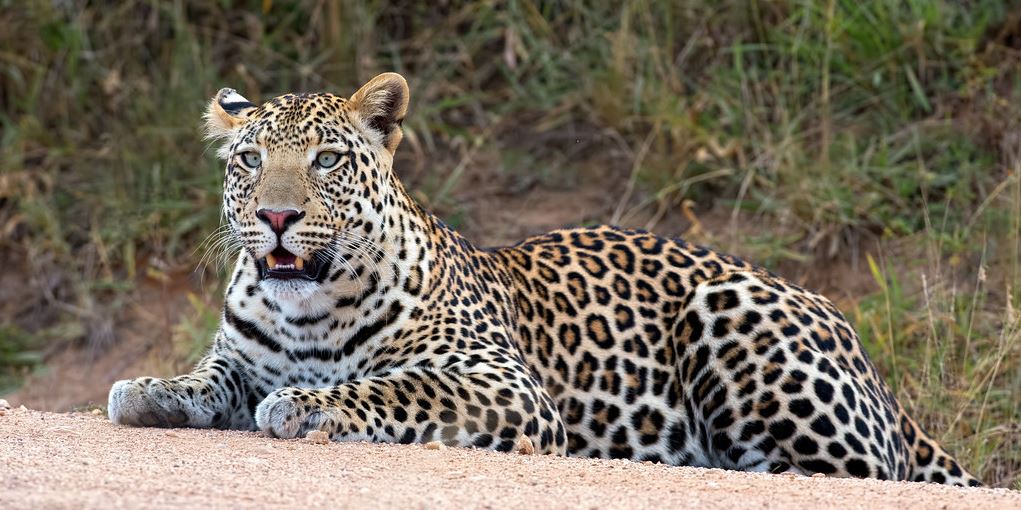
Identifying Leopards
Observing a leopard necessitates patience and acute perception. Examine the unique markings on trees, rocky outcrops, or riverbeds. Leopards are typically active during twilight hours, making dawn and dusk optimal periods for observation. Heed the alarm calls of other animals, such as monkeys or birds, which may signify the proximity of a leopard. Tracks and scat may serve as indicators of their whereabouts.
Locations to Observe African Leopards
Leopards are extensively found throughout sub-Saharan Africa; nevertheless, optimal locations for observing these safari animals include:
Sabi Sands Game Reserve, South Africa: This exclusive reserve is distinguished for its elevated leopard population and exceptional wildlife observation prospects. The leopards in this area are accustomed to automobiles, facilitating observation.
Masai Mara National Reserve, Kenya: The Mara’s varied ecosystems, comprising broad grasslands, riverine woodlands, and rocky formations, create optimal conditions for leopards.
South Luangwa National Park, Zambia: This park is renowned for its walking safaris, providing distinctive possibilities to track leopards and other animals on foot.
The Okavango Delta in Botswana features a complex system of waterways and islands that serves as a sanctuary for leopards, while boat safaris provide an opportunity to observe them from another vantage point.
Kruger National Park, South Africa: Although less renowned for leopards than Sabi Sands, Kruger’s extensive area and diverse terrain nonetheless offer favorable opportunities for sightings, especially in the southern portion.
Rhinoceros
The rhinoceros is a critically endangered species, a formidable and ancient-looking animal characterized by its thick skin and prominent horns. These solitary herbivores are characterized by their limited vision but possess an exceptional sense of smell and hearing. Regrettably, their horns are in high demand within the illicit wildlife trade, making them a target for poachers and causing their populations to decline to perilously low levels.
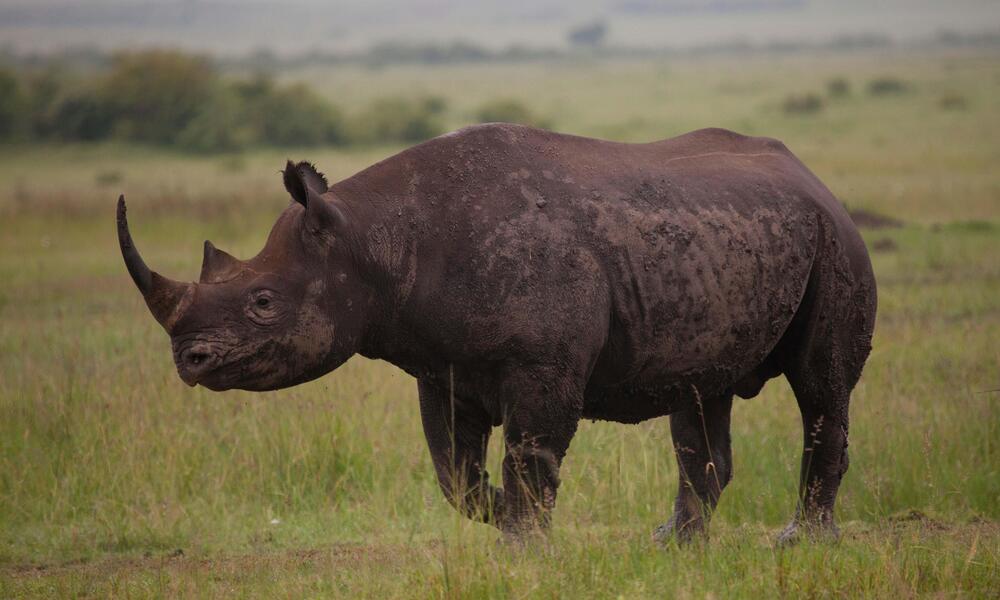
Identifying Rhinoceroses
Rhinoceroses are typically reticent and elusive, rendering them challenging to observe in their natural habitat. They are predominantly nocturnal, which exacerbates the difficulty. Nevertheless, with experienced guides and a stroke of fortune, you might observe them foraging on foliage or wallowing in mire. Observe their characteristic large footprints and feces, frequently located in accumulations known as middens.
Locations to Observe Rhinoceroses
Owing to their endangered status, rhinos inhabit restricted regions, predominantly within protected reserves and national parks. Notable locations for viewing them include:
Etosha National Park, Namibia: Etosha hosts a substantial population of black rhinos, frequently observed near the park’s waterholes, particularly during nocturnal hours.
Damaraland, Namibia: This area provides distinctive prospects for on-foot rhino tracking, guided by specialists dedicated to the conservation of these endangered species.
Kruger National Park, South Africa: Kruger boasts a significant number of black rhinos, although encounters are less frequent than in certain other parks.
Lewa Wildlife Conservancy, Kenya: This private conservancy is renowned for its effective rhino conservation initiatives and provides exceptional opportunities for wildlife observation.
Ol Pejeta Conservancy, Kenya: This site is home to the last two northern white rhinos and boasts a robust population of black rhinos, rendering it significant for rhino conservation efforts.
Ziwa Rhino Sanctuary, Uganda: The sole location in Uganda to observe more than twenty northern white rhinoceros.
Rhino conservation is a vital concern, with numerous organizations diligently striving to safeguard these remarkable animals from poaching and habitat destruction. Visiting these places and endorsing conservation initiatives can aid in the preservation of the black rhinoceros.
Cheetah
The cheetah is the fastest terrestrial animal, capable of attaining speeds of up to 70 mph in brief sprints. Their lithe physiques, elongated limbs, and dappled pelage are well suited for velocity and nimbleness. Cheetahs are diurnal predators, indicating they exhibit peak activity during daylight hours, in contrast to numerous other large felines. They depend on their remarkable speed to pursue prey, resulting in exhilarating observations during a safari.
Identifying Cheetahs
Seek cheetahs in expansive grasslands and savannas, where they possess ample space to sprint. They frequently perch on termite mounds or other elevated locations to survey the terrain for prey. Cheetahs are comparatively timid and are among the most challenging African safari animals to approach; yet, their unique markings facilitate distant identification. Their elongated tails, characterized by a black tip, serve as a distinguishing feature.
Locations to Observe Cheetahs
Cheetahs inhabit various regions of Africa; however, their populations are dispersed and under decline. Notable locations for viewing them include:
The Masai Mara National Reserve in Kenya features expansive plains that serve as optimal hunting territories for cheetahs, making sightings very frequent.
Serengeti National Park, Tanzania: The expansive grasslands of the Serengeti provide an optimal home for cheetahs, especially in the southern Serengeti region.
The Okavango Delta in Botswana features varied habitats such as grasslands, woods, and floodplains that sustain a robust population of cheetahs.
The Namibian Cheetah Conservation Fund is committed to cheetah preservation and provides opportunities to observe these majestic felines in their natural environment.
The Kalahari Desert, located between Botswana and Namibia, hosts a distinctive population of cheetahs adapted to its harsh habitat.
Kidepo Valley National Park, Uganda: Despite being lesser-known than other parks, Kidepo’s expansive savannas offer exceptional habitat for cheetahs, facilitating unusual observations away from the masses.
Giraffe
The giraffe is the tallest terrestrial animal, easily identifiable by its elongated neck, limbs, and unique patterned pelage. These large herbivores utilize their stature to access the foliage of acacia trees, which is beyond the reach of other African safari wildlife. Their tranquil disposition and distinctive look render them a favorite among safari enthusiasts, particularly children. Giraffes are sociable creatures, frequently observed in loose aggregations known as towers, traversing the savannas.
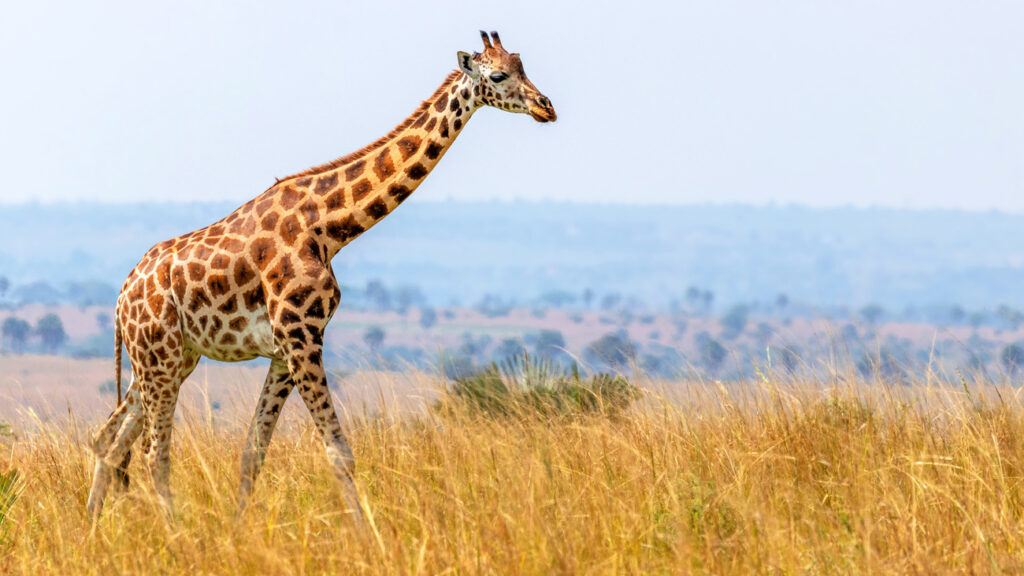
Identifying Giraffes
Giraffes are easily identifiable due to their stature, enabling them to survey over elevated grasses and plants. Observe their elongated necks and mottled patterns set against the savanna landscape, particularly in regions abundant with acacia trees, which serve as their favored food source. They exhibit heightened activity throughout the colder periods of the day; so, early mornings and late afternoons are optimal for seeing them foraging on foliage or drinking at water sources. They may also be observed interacting with other species, like as zebras and antelopes, with whom they frequently share grazing areas.
Locations to Observe Giraffes
Giraffes inhabit sub-Saharan Africa, with optimal viewing locations including:
The Masai Mara National Reserve in Kenya features vast plains that serve as an optimal habitat for giraffes, making sightings frequent.
Serengeti National Park, Tanzania: The expansive plains of the Serengeti sustain substantial numbers of giraffes, providing exceptional viewing prospects.
Etosha National Park, Namibia: The distinctive terrain of Etosha, characterized by salt pans and savannas, draws giraffes, particularly near waterholes.
Kruger National Park, South Africa: The park’s varied ecosystems sustain multiple subspecies of giraffe, including the uncommon Thornicroft’s giraffe.
Tarangire National Park, Tanzania: Tarangire is renowned for its substantial elephant herds and also hosts a robust population of giraffes, frequently observed near the Tarangire River.
Hippopotamus
Notwithstanding their cumbersome look, hippos exhibit remarkable agility both on land and in aquatic environments. These sizable, semi-aquatic mammals predominantly remain submerged in rivers and lakes during the day, surfacing at night to feed on vegetation. Hippopotamuses are recognized for their formidable jaws and keen dentition, rendering them among the most perilous creatures encountered on African safaris. Nonetheless, they are captivating to observe as they engage with one another and their surroundings.
Identifying Hippopotamuses
Hippos are predominantly observed in or near aquatic environments, where they allocate much of their time. Observe their huge, barrel-shaped physiques and characteristic snouts emerging from the water. Their vocalizations include loud grunts and snorts used for communication. Exercise caution when observing hippos, as they can exhibit unpredictability and aggression, particularly when they perceive a threat.
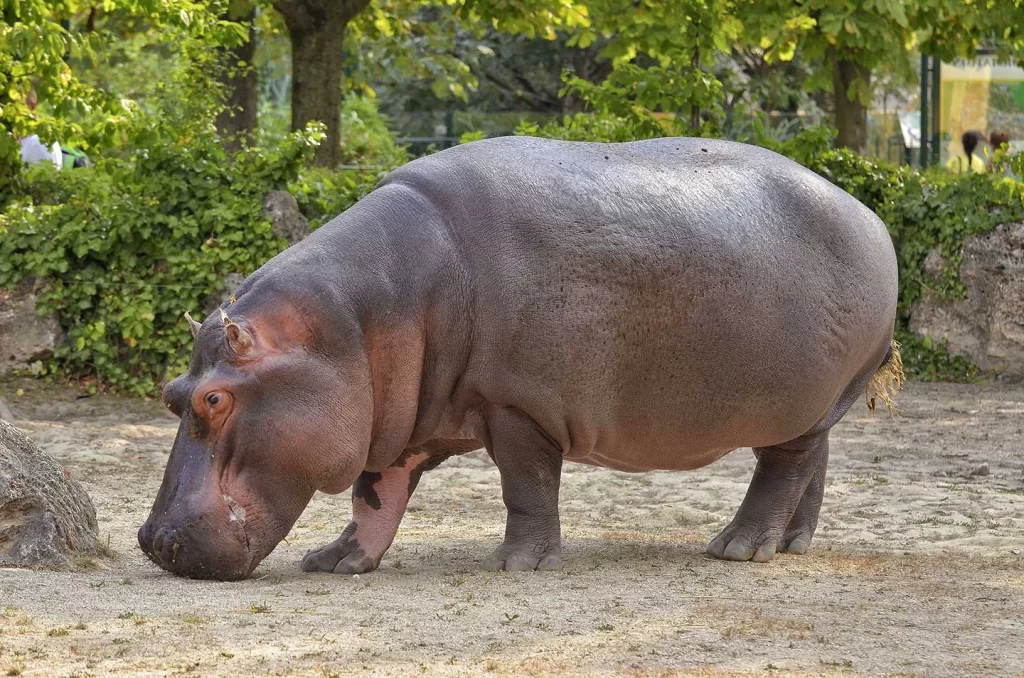
Locations to Observe Hippopotamuses
Hippopotamuses inhabit rivers, lakes, and marshes in sub-Saharan Africa. Notable locations for viewing them include:
The Okavango Delta in Botswana features plentiful rivers that serve as optimal habitats for hippos, while boat safaris present exceptional viewing prospects.
Chobe National Park, Botswana: The Chobe River hosts substantial pods of hippopotamuses, frequently observed sunbathing or foraging along the riverbanks.
Kruger National Park, South Africa: The rivers and dams of Kruger draw hippos, making sightings frequent on game drives.
Murchison Falls National Park and Queen Elizabeth National Park, Uganda: The Kazinga Channel and the Nile River in Murchison Falls are abundant in hippos, and boat excursions provide intimate encounters with these intriguing animals.
Lake Manyara National Park, Tanzania: Lake Manyara draws diverse species, including hippos, who are observable wallowing in the shallows or feeding along the shore.
Zebras disperse throughout the Ngorongoro Crater plain, intermingling with wildebeests. Zebras are distinctive African equines, characterized by their striking black and white stripes. The stripe pattern of each zebra is distinctive, akin to a fingerprint. These sociable creatures traverse the savannas in groups, frequently in the company of other herbivores such as wildebeest. Zebras are herbivorous animals that mostly consume grasses, and their acute vision and hearing enable them to identify predators. Their stripes are believed to fulfill several functions, such as camouflage, thermoregulation, and individual recognition.
Identifying Zebras
Zebras are readily identifiable due to their unique markings. Seek them on expansive grasslands and savannas, where they forage in groups. They are frequently located near other herbivores, such as wildebeest and gazelles. Their stripes may seem to merge from afar, producing a captivating optical illusion. Attend to their vocalizations and scrutinize their social dynamics within the herd, encompassing playful foals and vigilant stallions. One may observe a zebra’s remarkable speed and agility while it eludes a predator.
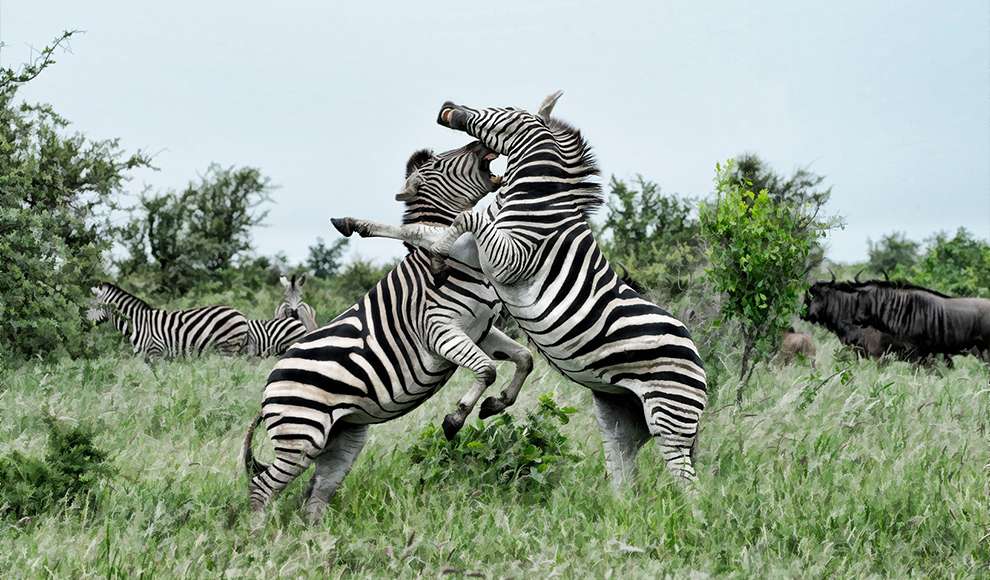
Locations to Observe Zebras
Zebras inhabit diverse regions of Africa, with optimal viewing locations including:
Masai Mara National Reserve, Kenya: The expansive plains of the Mara host substantial populations of zebras, particularly during the Great Migration when they accompany millions of wildebeest on their monumental trek.
Serengeti National Park, Tanzania: The grasslands of the Serengeti sustain significant zebra herds, providing exceptional viewing chances year-round.
Etosha National Park, Namibia: The salt pans and savannas of Etosha draw zebras, especially near waterholes where they congregate to hydrate.
Kruger National Park, South Africa: The park hosts both plains zebras and the smaller mountain zebras, which inhabit its elevated regions.
Hwange National Park, Zimbabwe: This park features substantial herds of zebras frequently observed in conjunction with elephants and other herbivores near the park’s abundant waterholes.
A chimpanzee seated in Kibale National Park, Uganda. Chimpanzee
Chimpanzees are our nearest extant relatives, sharing over 98% of our DNA. These cognitive primates are recognized for their intricate social hierarchies, utilization of tools, and aptitude for problem-solving. Observing chimpanzees in their natural habitat is a profound experience, as one witnesses their playful interactions, grooming behaviors, and instances of conflict. Chimpanzees are omnivorous, mostly consuming fruits, leaves, and insects, while also hunting and consuming small mammals.
Identifying a Chimpanzee
Chimpanzees inhabit deep rainforests, where their calls are frequently audible prior to becoming visible. Pay attention to their vocalizations, which may include hoots, screams, and pant-hoots, a distinctive kind of communication employed over great distances. Chimpanzee nests, constructed high in the arboreal environment, signify their existence. Monitoring chimpanzees can be arduous; nevertheless, seasoned guides can direct you to their typical habitats.
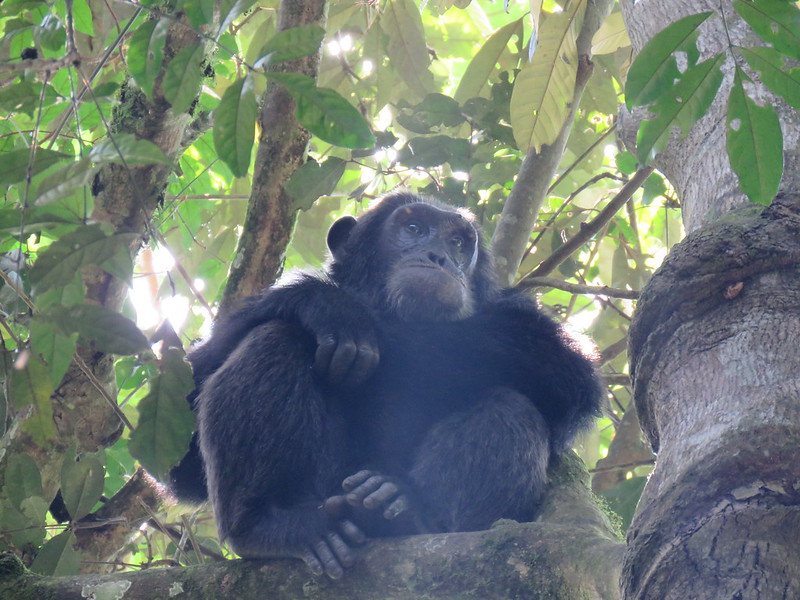
Locations for Observing Chimpanzees
Chimpanzees inhabit various nations in East and Central Africa, with some of the premier locations for observing them being:
Kibale National Park, Uganda: This park is distinguished for its substantial chimpanzee population and provides exceptional opportunities for chimpanzee tracking and habituation experiences.
Mahale Mountains National Park, Tanzania: This secluded park along the shores of Lake Tanganyika hosts a flourishing group of chimpanzees, recognized for their distinctive behaviors and proficiency in tool use.
Gombe Stream National Park, Tanzania: This location served as the site of Jane Goodall’s pioneering research on chimpanzees and remains an essential area for chimpanzee conservation and study.
Nyungwe Forest National Park, Rwanda: Nyungwe Forest features a substantial chimpanzee population and provides opportunities for both chimpanzee tracking and canopy walks, offering varied viewpoints of their environment.
Budongo Forest Reserve, Uganda: This reserve hosts a habituated colony of chimpanzees, facilitating more accessible and reliable encounters.
Chimpanzee trekking permits are essential and should be reserved far ahead of time due to restricted availability. These licenses facilitate conservation initiatives and provide financial support for the safeguarding of these endangered primates.
Cape Buffaloes
The Cape buffalo, an emblematic safari species in Africa and part of the “Big Five,” is a robust and erratic bovine recognized for its substantial horns and strong force. These sociable creatures traverse the savannas and grasslands of Africa in enormous herds, frequently surpassing several hundred members. Buffaloes are herbivorous, consuming grasses and reeds, and their formidable horns serve as a defense against predators and competitors. They are recognized for their robust herd instinct and will ardently defend their offspring and weak individuals.
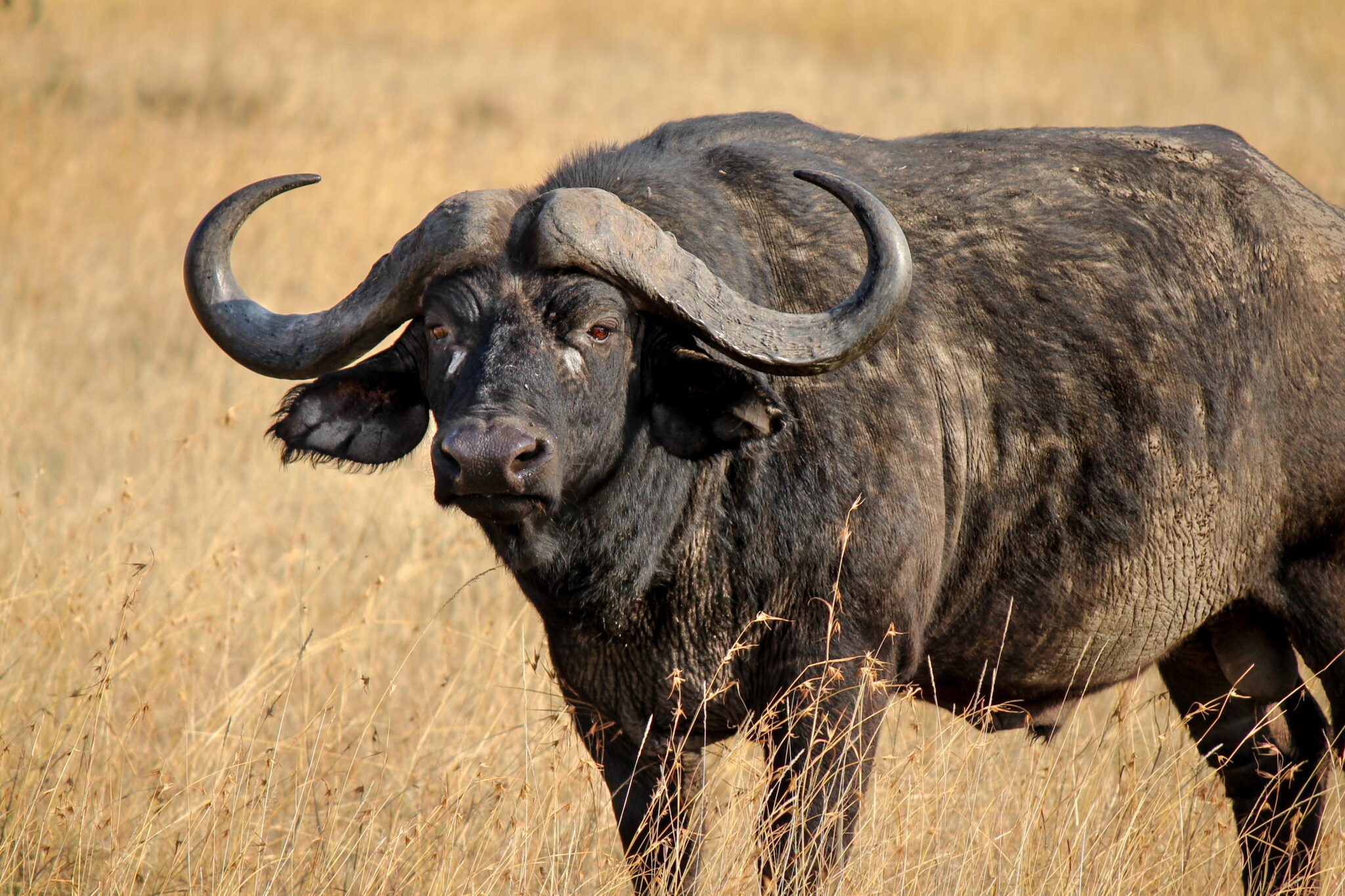
Identifying Cape Buffalos
Cape buffaloes are readily identifiable because to their substantial size and characteristic horns. Search for them in open spaces, adjacent to water sources, or within dense thickets where they find shelter from sunlight. They frequently engage in wallowing in mud to thermoregulate and shield themselves from parasites. Pay attention to their profound grunts and snorts, audible from afar.
Locations to Observe Cape Buffalo
Cape buffaloes inhabit the majority of African National Parks, and they are readily observable upon entering the sanctuary. However, some of the most optimal locations to observe them include:
Kruger National Park, South Africa, is home to one of the largest buffalo populations in Africa, providing exceptional opportunities to monitor their behavior and social dynamics.
Chobe National Park, Botswana: The Chobe River and adjacent floodplains host substantial herds of buffalo, frequently observed grazing or traversing the river in striking displays.
Masai Mara National Reserve, Kenya: The grasslands and woods of the Mara offer an ideal habitat for buffalo, making them frequently observed during game drives.
Hwange National Park, Zimbabwe: This park hosts a substantial population of buffalo, frequently observed gathering near waterholes, particularly during the dry season.
Selous Game Reserve, Tanzania: This expansive reserve features a substantial and varied buffalo population, providing opportunities to observe them in multiple settings, ranging from wide savannas to riverine zones.
